My Genographic results
I participated in the Genographic project, a joint venture by IBM, National Geographic and the Waitt Family Foundation. By testing the DNA from your Y-chromosome (for men) and/or from your mitochondrial DNA, the migrations of your paternal and maternal ancestors can be tracked on a scale of some 10,000 years.
I've written extensively about this on my Dutch blog (1 2 3 4 5), but I will summarize my results here, concentrating on information useful for genealogists that have also tested their DNA and got some matches with my DNA.
Based on my Y-chromosomial DNA, transmitted by a father to his sons, I belong to haplogroup R1b, which is the most common one in Western Europe. You can see my complete results of 37 loci (12 standard through Genographic and 25 additional through FamilyTreeDNA) at Ysearch.org, and in this table:

This is what the Genographic project tells me about haplogroup R1b, which determines my paternal ancestry line:
Your Y chromosome results identify you as a member of haplogroup R1b, a lineage defined by a genetic marker called M343. This haplogroup is the final destination of a genetic journey that began some 60,000 years ago with an ancient Y chromosome marker called M168.
The very widely dispersed M168 marker can be traced to a single individual-"Eurasian Adam." This African man, who lived some 31,000 to 79,000 years ago, is the common ancestor of every non-African person living today. His descendants migrated out of Africa and became the only lineage to survive away from humanity's home continent.
Population growth during the Upper Paleolithic era may have spurred the M168 lineage to seek new hunting grounds for the plains animals crucial to their survival. A period of moist and favorable climate had expanded the ranges of such animals at this time, so these nomadic peoples may have simply followed their food source.
Improved tools and rudimentary art appeared during this same epoch, suggesting significant mental and behavioral changes. These shifts may have been spurred by a genetic mutation that gave "Eurasian Adam's" descendants a cognitive advantage over other contemporary, but now extinct, human lineages.
Some 90 to 95 percent of all non-Africans are descendants of the second great human migration out of Africa, which is defined by the marker M89.
M89 first appeared 45,000 years ago in Northern Africa or the Middle East. It arose on the original lineage (M168) of "Eurasian Adam," and defines a large inland migration of hunters who followed expanding grasslands and plentiful game to the Middle East.
Many people of this lineage remained in the Middle East, but others continued their movement and followed the grasslands through Iran to the vast steppes of Central Asia. Herds of buffalo, antelope, woolly mammoths, and other game probably enticed them to explore new grasslands.
With much of Earth's water frozen in massive ice sheets, the era's vast steppes stretched from eastern France to Korea. The grassland hunters of the M89 lineage traveled both east and west along this steppe "superhighway" and eventually peopled much of the continent.
A group of M89 descendants moved north from the Middle East to Anatolia and the Balkans, trading familiar grasslands for forests and high country. Though their numbers were likely small, genetic traces of their journey are still found today.
Some 40,000 years ago a man in Iran or southern Central Asia was born with a unique genetic marker known as M9, which marked a new lineage diverging from the M89 group. His descendants spent the next 30,000 years populating much of the planet.
Most residents of the Northern Hemisphere trace their roots to this unique individual, and carry his defining marker. Nearly all North Americans and East Asians have the M9 marker, as do most Europeans and many Indians. The haplogroup defined by M9, K, is known as the Eurasian Clan.
This large lineage dispersed gradually. Seasoned hunters followed the herds ever eastward, along a vast belt of Eurasian steppe, until the massive mountain ranges of south central Asia blocked their path.
The Hindu Kush, Tian Shan, and Himalaya, even more formidable during the era's ice age, divided eastward migrations. These migrations through the "Pamir Knot" region would subsequently become defined by additional genetic markers.
The marker M45 first appeared about 35,000 to 40,000 years ago in a man who became the common ancestor of most Europeans and nearly all Native Americans. This unique individual was part of the M9 lineage, which was moving to the north of the mountainous Hindu Kush and onto the game-rich steppes of Kazakhstan, Uzbekistan, and southern Siberia.
The M45 lineage survived on these northern steppes even in the frigid Ice Age climate. While big game was plentiful, these resourceful hunters had to adapt their behavior to an increasingly hostile environment. They erected animal skin shelters and sewed weathertight clothing. They also refined the flint heads on their weapons to compensate for the scarcity of obsidian and other materials.
The intelligence that allowed this lineage to adapt and thrive in harsh conditions was critical to human survival in a region where no other hominids are known to have survived.
Members of haplogroup R are descendents of Europe's first large-scale human settlers. The lineage is defined by Y chromosome marker M173, which shows a westward journey of M45-carrying Central Asian steppe hunters.
The descendents of M173 arrived in Europe around 35,000 years ago and immediately began to make their own dramatic mark on the continent. Famous cave paintings, like those of Lascaux and Chauvet, signal the sudden arrival of humans with artistic skill. There are no artistic precedents or precursors to their appearance.
Soon after this lineage's arrival in Europe, the era of the Neanderthals came to a close. Genetic evidence proves that these hominids were not human ancestors but an evolutionary dead end. Smarter, more resourceful human descendents of M173 likely outcompeted Neanderthals for scarce Ice Age resources and thus heralded their demise.
The long journey of this lineage was further shaped by the preponderance of ice at this time. Humans were forced to southern refuges in Spain, Italy, and the Balkans. Years later, as the ice retreated, they moved north out of these isolated refuges and left an enduring, concentrated trail of the M173 marker in their wake.
Today, for example, the marker's frequency remains very high in northern France and the British Isles-where it was carried by M173 descendents who had weathered the Ice Age in Spain.
Members of haplogroup R1b, defined by M343 are the direct descendents of Europe's first modern humans-known as the Cro Magnon people.
Cro-Magnons arrived in Europe some 35,000 years ago, during a time when Neanderthals still lived in the region. M343-carrying peoples made woven clothing and constructed huts to withstand the frigid climes of the Upper Paleolithic era. They used relatively advanced tools of stone, bone, and ivory. Jewelry, carvings, and intricate, colorful cave paintings bear witness to the Cro Magnons' surprisingly advanced culture during the last glacial age.
When the ice retreated genetically homogenous groups recolonized the north, where they are still found in high frequencies. Some 70 percent of men in southern England are RIb. In parts of Spain and Ireland that number exceeds 90 percent.
There are many sublineages within R1b that are yet to be defined. The Genographic Project hopes to bring future clarity to the disparate parts of this distinctive European lineage.
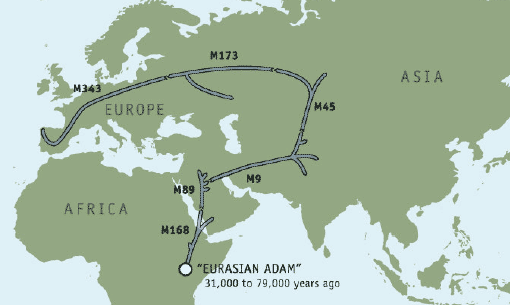
Based on my mitochondrial DNA, I belong to haplogroup H, which is also the most common one in Europe. You can see the complete results of my HVR1 region at MitoSearch.org. Essentially, my HVR1 region shows only two mutations compared to the Cambridge Reference Set of mitochondrial DNA: 16294T and 16304C.
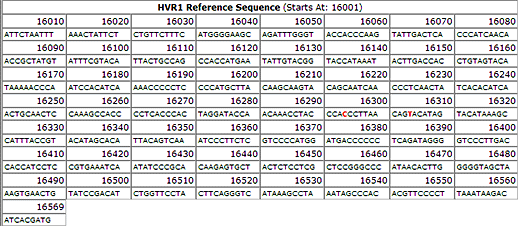
The mitochondrial DNA is transmitted by the mother to all her children, so essentially I inherited my mitochondrial DNA through my maternal ancestry line, the mother of the mother of the mother... of my mother.
Mitochondrial haplogroup H is a predominantly European haplogroup that participated in a population expansion beginning approximately 20,000 years ago. Today, about 30% of all mitochondrial lineages in Europe are classified as haplogroup H. It is rather uniformly distributed throughout Europe suggesting a major role in the peopling of Europe, and descendant lineages of the original haplogroup H appear in the Near East as a result of migration. Future work will better resolve the distribution and historical characteristics of this haplogroup. Bryan Sykes in his Seven Daughters of Eve book named this mtDNA haplogroup Helena.
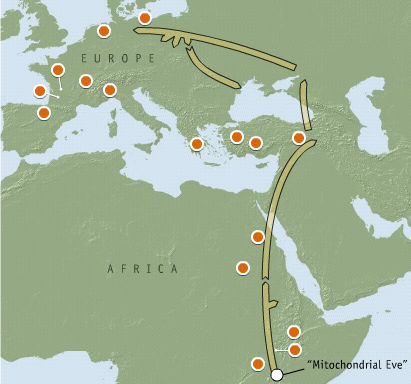
WHAT ABOUT THE LAST FEW CENTURIES?
After reading the above, you understand that the haplogroups are telling us something about the migration of our ancestors (to be exact: only some of our ancestors - only those in the straight paternal and maternal lineage) in a timeframe from approximately 100,000 years ago till approximately 5,000 years ago.
But this DNA analysis can tell us more. By comparing the DNA of two individuals, one can predict the statistical probability that those two had a common ancestor in the last centuries.
Let's take an example. The websites of Family Tree DNA and Ysearch.org have databases of test results from people who have agreed to publication for genealogic purposes. The database contains their name, their e-mail address, their origin and their genetic markers. So, I can search the database for people that have exactly the same values for the 25-marker test of the Y-chromosome. And there are tools to compare near-matches. Here's an example:
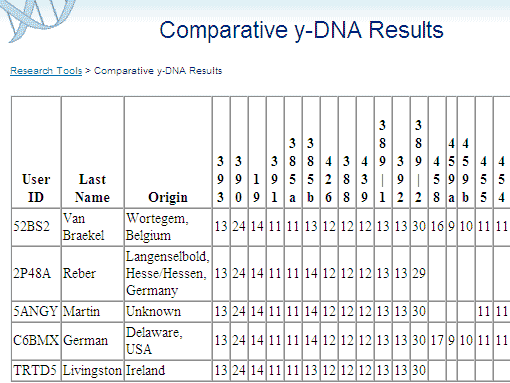
I'm only showing the leftmost part of the table. The last names are relevant because normally, the last name is inherited together with the Y-chromosome: from father to sons. We see that mister German from Delaware and I are sharing almost exactly the same values on 25 loci, except for 2 loci: 385b and 458. What is this telling us about the possibility of a common ancestry? The Family Tree DNA website has a calculator for that, which gives us this result:

So, according to the table above, there is a chance of more than 90% that Mr. German and me have a common ancestor in direct paternal lineage within the last 24 generations, which is approximately 600 years. Mind you, "direct paternal lineage" means: the father of my father's father father ... and so on. Considering that I have traced back my direct paternal lineage until the early 1600's, and that these forefathers were all living in a small area in the western part of Belgium, I find this hard to believe. Especially because in this region, people have started using last names since the 11th or 12th century. If mister German would have a name that sounded like "Brackeley", I would be more inclined to believe this calculation.
But the calculator has some important small print:
The above numbers are based exclusively on the comparison of their Y-DNA results, which show 2 mismatches. However, these results can be refined if their paper trail indicates that no common ancestor between Mr. Luc Van Braekel and Mr. ... could have lived in a certain number of past generations.
So, because it is very unlikely that our common ancestor lived in the last 400 years (16 generations), we will refine the calculation.

So, with that additional information, there is now a 90% chance that we shared a common forefather in direct male line in the last 32 generations, or 800 years, or between the years 1200 and 1600. Which, again, I find amazing.
The database contains 5 other individuals that yield approximately the same probabilities. Of these five, three have last names that resemble the name of mister German: Jarman, Jarmon and German. Another is called Hancock, and another one Webb. This technique of calculating the probability of a common y-chromosome ancestor was established at the first International Conference on Genetic Genealogy on October 30, 2004. So it is fairly recent.
Oh, and for those of you who are contemplating the possibility that during one of both World Wars of the 20th century, some soldier from the German occupation army would have contributed to my current genetic configuration: there are too many striking physical and psychological similarities between me and my late grandfather who was born in 1894, so that we can safely eliminate this possibility.
How is it possible that I have a close genetic distance, based on the Y-chromosome, with people that have different surnames? This is the explanation:
Dr. Luigi Lucca Cavalli-Sforza, Professor Emeritus, Stanford University, in his fascinating book: The Great Human Diasporas: The History of Diversity and Evolutions says that the total population of Europe was 60,000 people at the end of the last Ice Age, about 10,000 years ago. Now Europe has a population of 300 million people. This increase is almost entirely due to a natural increase in population rather than immigration from other continents. Keeping this in mind it is reasonable that many people alive today in Europe will match with other Europeans from BEFORE the time that our ancestors began the adoption of surnames, and when you match someone who has a different surname your first thought should be that the ‘connection’ is distant rather then recent.
The same can be done for the mitochondrial DNA. I only tested the HVR1, which is a low resolution test. The Family Tree DNA database gives 10 exact matches for the HVR1 loci. Mitosearch.org only gives one exact match.
MY OWN GENEALOGICAL RESEARCH: THE PLACES
Because several people that are showing near or exact matches with my y-DNA or mitochondrial DNA have already contacted me to ask for possible common ancestors, I will now summarize my own genealogical research (performed in 1990 and 1991), without losing ourselves in unnecessary details.
I am a Dutch-speaking citizen of Belgium and I have traced both my paternal and maternal lineage back to the 17th century. All these ancestors lived in confined areas in the western part of Belgium, in the provinces of East and West Flanders. My mitochondrial ancestors lived in Roeselare from the end of the 17th century, my Y-chromosome ancestors lived in the region between Wortegem, Waregem, Harelbeke, Zwevegem and Sint-Denijs from around 1620 until now.
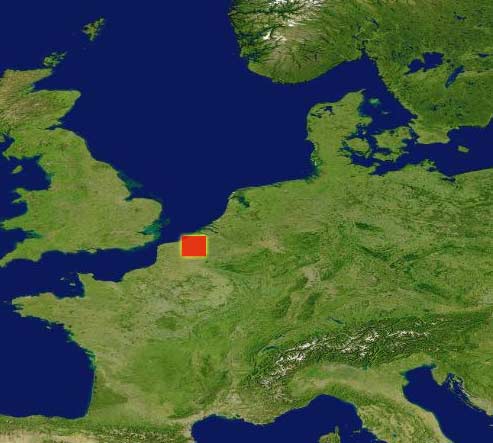
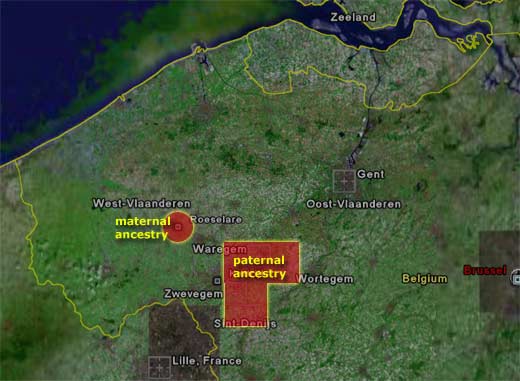
MY OWN GENEALOGICAL RESEARCH: THE NAMES AND THE DATES
My Y-chromosome lineage:
Luc Van Braekel (Aalst 1958 - )
Roger Van Braekel (Waregem 1930 - ) x Ingrid Vandenbroucke
Gerard Van Braekel (Waregem 1894 - Waregem 1975) x Maria Van Geluwe
Jules Van Braekel (Waregem 1861 - Waregem 1937) x Emma Desmet
Leo Van Braekel (Waregem 1823 - Waregem 1885) x Rosalia Kindts
Petrus Jacobus Van Braekel (Waregem 1770 - Waregem 1842) x Isabella Verschae
Jean Baptiste Van Braekel (Desselgem 1737 - Waregem 1812) x Maria Anna Laridon
Joannes Van Braekel (Wortegem 1704 - Waregem 1771) x Anne Marie Decraene
Jacobus Van Braekel (Wortegem 1668 - Wortegem 1725) x Jacoba De Waele
Joos Van Brakele (Zwevegem 1641 - Wortegem 1705) x Joanna De Smet
Jan Van Brakele (? - Wortegem 1665) x Catharina Struyve
My mitochondrial lineage:
Luc Van Braekel (Aalst 1958 - )
Ingrid Vandenbroucke (Roeselare 1929 - ) x Roger Van Braekel
Alice Ampe (Staden 1904 - Roeselare 1968) x Wilfried Vandenbroucke
Maria Devogel (Roeselare 1874 - Roeselare 1950) x Arsène Ampe
Coralie Raveschot (Roeselare 1848 - Roeselare 1925) x Charles-Louis Devogel
Barbara Demeester (Roeselare 1817 - Roeselare 1886) x Franciscus Raveschot
Florentina Ostyn (Roeselare 1784 - Roeselare 1825) x Petrus Demeester
Isabelle Biebuyck (Roeselare 1755 - Roeselare 1808) x Clement Ostyn
Anna Denys (Roeselare 1721 - Roeselare 1795) x Joseph Biebuyck
Joanna Bert (Roeselare 1697 - Roeselare 1781) x Willem De Nijs
Albertina Soenen (? - Roeselare 1710) x Ignatius Bert

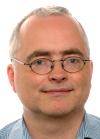

Reacties
David Baeckelandt
woensdag, 2 september, 2009 - 10:54Luc, This is great stuff. I don't know if you have seen Guido DeBoeck's "Flemish DNA & Ancestry" book (Dokus, 2007)but if not I strongly recommend it.
All the best,
David Baeckelandt
DeWinter
maandag, 20 juli, 2009 - 16:19Een echte vlaming :)
Marie-Anne
donderdag, 28 augustus, 2008 - 15:01Hi Luc,
What a wonderful site1 Sorry I don't speak Flemish.
I'm Australian, but my mother was from Mouscron, and her entire family came from the same little pocket of Belgium as yours.
Part of what fascinates me is that your grandmother's grandmother was Coralie Raveschot, from Rouselare.
My grandfather's grandmother, was Julienne Romanie Raveschot, born in Rouselare in 1830. Have you come across her in your research?
Thanks.
Jenny
dinsdag, 21 augustus, 2007 - 11:07Hi Joe,
Yes, this is my Grandfather and Grand mother(Clarice Blanche Leoie DeSiliva). My Gfather's second marraige. The only thing is tracing it way back. We cant seem to find it.
May I know if your Sri Lankan?
The funny thing is they have not mentioned my Father name(Donald Andries,Godfrey A... Derek A..) We have not made this. Maybe one of my Aunties in Australis, whom I have no contact. My Uncle(Mervyn Andriesz) is the one who is really interested. I am trying to help and also curious too.
If this Julian Andriesz is contected to us in anyway. it might help.
Thanks a heap.
Jenny
joe
maandag, 20 augustus, 2007 - 21:40@jenny: does this ring a bell?
(2) Julian Andriesz (John Matthew), son of (1) John Matthew Andriesz who married (MRIN:6919) Josephine Eleanor Elders on 9 Feb 1874.
Julian married (1-MRIN:2282) Helen Holmes. They had the following children: Hazel Millicent Eleanor Andriesz was born 31 Aug 1914.
Third Generation
3. Hazel Millicent Eleanor Andriesz (Julian, John Matthew) was born 31 Aug 1914.
Hazel married (MRIN:2281) Montague Neil St John De La Harpe, son of Jerome Xystus De La Harpe and Charlotte Sophia Keith (MRIN:4513), on 23 Jun 1930 in St Mary's Cathedral, Bambalapitiya. Montague was born 2 May 1904.
They had the following children:
Montague Neil St John De La Harpe was born 27 May 1931.
Mareelene Nelia De La Harpe was born 2 Oct 1932 in Colombo, ceylon.
Vilette Arlene Eleanor De La Harpe was born 27 Mar 1936 in Colombo, ceylon.
Fourth Generation
5. Montague Neil St John De La Harpe (Hazel Millicent Eleanor Andriesz, Julian, John Matthew) was born 27 May 1931 in Colombo, Ceylon.
Montague married (MRIN:2283) Agatha Joyce Yvonne Caspersz, daughter of Paul Robert Bernadin Prosper Caspersz and Emelda Patricia Gonsal (MRIN:4354), on 14 Mar 1961 in All Saint's Church, borella. Agatha was born 7 Feb 1934 in Colombo, ceylon. She died 29 Apr 1997 in Windsor, Berkshire, England.
Yvonne was born on the 7th February, 1934 in Colombo SriLanka. She had her entire education at Good Shepherd Convent, Colombo.
She was a great big sister, very soft spoken and always there for us, especially since Mum died at the age of 49, and Yvonne played the part of being the head of the family. Her musical talents were very creditable with certificates from the Royal College of Music (LRSM) and Trinity College of Music (LTCL). She married Neil De La Harpe on the 14th of February 1961 and sailed the high seas with Neil for a year as he was a Marine Engineer. The twins were born in 1962 and this brought her back to SriLanka for their birth. She left to join Neil in England in November 1963.
During Yvonne’s time in England, she made us very proud with her music, playing for the Council school, and having her own pupils. She was a wonderful mother to her children and they all miss her dearly. However she has left a legacy to her children, in her music, as they are all musical.
Yvonne, died in England on the 29th April, 1997.
They had the following children:
Ann Kathleen De La Harpe was born 1 Sep 1962.
Helen Marguerite De La Harpe was born 1 Sep 1962.
David William De La Harpe was born 13 May 1964.
Trevor Michael De La Harpe was born 6 Mar 1967 in Slough, Berkshire.
Andrew John De La Harpe was born 10 Sep 1968 in Slough, Berkshire.
Fifth Generation
8. Ann Kathleen De La Harpe (Montague Neil St John De La Harpe, Hazel Millicent Eleanor Andriesz, Julian, John Matthew) was born 1 Sep 1962.
Ann married (MRIN:3571) Anthony Sloane on 29 Apr 1995 in Ascot, Berkshire, England. Anthony was born 19 Sep 1961.
They had the following children:
Emily Evelyn Sloane was born 6 Dec 1996.
Christopher William Sloane was born 24 Jan 2002 in Ascot, Berkshire, England.
9. Helen Marguerite De La Harpe (Montague Neil St John De La Harpe, Hazel Millicent Eleanor Andriesz, Julian, John Matthew) was born 1 Sep 1962 in Colombo, Ceylon.
Helen married (MRIN:4358) Robert Bokenham Abbott, son of Frank Anthony Bokenham Abbott (MRIN:6082), on 2 May 1987 in Holy Family Church, Langley. Robert was born 17 Jan 1957 in Hounslow.
They had the following children:
Jamie William Bokenham Abbott was born 11 Aug 1991 in Slough, Berkshire, England.
Rebecca Elizabeth Abbott was born 2 Nov 1993 in Slough, Berkshire, England.
David William Abbott.
10. David William De La Harpe (Montague Neil St John De La Harpe, Hazel Millicent Eleanor Andriesz, Julian, John Matthew) was born 13 May 1964.
David married (MRIN:5893) Laura Bagley. Laura was born 6 Mar 1965 in Worcester.
They had the following children:
William De La Harpe was born 20 Aug 1995.
Louise Catherine De La Harpe was born 11 May 1998.
Anne Olivia De La Harpe was born 23 Oct 2001.
Sixth Generation
17. David William Abbott (Helen Marguerite De La Harpe, Montague Neil St John De La Harpe, Hazel Millicent Eleanor Andriesz, Julian, John Matthew) was born in Ealing, Middlesex.
David married (MRIN:4343) Laura Bagley in Sep 1994 in Worcester. Laura was born 6 Mar 1965 in Worcester.
They had the following children:
Matthew William Abbott was born 20 Aug 1995 in Hillingdon, Middlesex.
Louise Catherine Abbott was born 31 May 1998 in Reading, Berkshire.
Amy Olivia Abbott was born 23 Oct 2001 in Reading, Berkshire.
Julian also married (2-MRIN:6950) Clarice Blanche Leonie De Silva, daughter of Bertie De Silva (MRIN:6948), on 28 Dec 1925. They had the following children: Mervyn Andriesz.
LVB
maandag, 20 augustus, 2007 - 18:21@jenny: Please disregard the comments by Joe, he is only joking.
Jenny
maandag, 20 augustus, 2007 - 09:18Hi Joe,
HOw can I get in touch with Julian Andriesz?
Please let me know.
Thanks,
Jenny
joe
maandag, 6 augustus, 2007 - 20:54Jenny, well: he shouts constantly that he wants Ceylon tea, and not this pee-stinky Pickwick Douwe Egberts. And Ceylon is almost the same as Sri Lanka, right?
And you know, last time in café "De Dikke tet" we were watching CNN and saw a commercial about tax-free shopping in Dubai, and Julian shouted: "I'm going there, I need a new Rolex!" I think he was pretty serious about it. Where in Dubai do you live? Close to the Burj Al Arab
jenny
zondag, 5 augustus, 2007 - 10:26Hi traveller,
How can I get these records. How can I trase this info.
Regards,
Jenny
jenny
zondag, 5 augustus, 2007 - 10:23Hi Joe,
Its very strange that you found this person. Is he Sri Lankan. because the Julian I know is my cousin and he's tall and fair complextion. If you meet him again please find out from where he is. I'm from Sri Lanka, living in Dubai.
It will be great help.
Regards,
Jenny
traveller
donderdag, 26 juli, 2007 - 20:29@ Jenny
After meeting Zulma, and after having drunk all the beer in the bar, you could also try looking for the familybible which most dutch people carried on their migrant travels.
Your familyname is probably originally: Andrieszoon.
I had a real life experience with this when a texan told me his name was Driggs and he showed me his old familybible.
He thought it was a bible in old english and he couldn't read it.
The bible was in old flemish and his familyname had evolved from DE RIJCKE over DRIJCKE to DRIGGS.
His ancestors were from Gent in Flanders 300 years before.
joe
woensdag, 25 juli, 2007 - 08:23Hi Jenny,
last week at the Geinstsche Fieste I bumped into a shabby and chubby looking person in café "In De Dikke Tet" (where Zulma with the brown moustache stands at the tap), and he told me his name is Julian Mathew Andriesz. I can explain you how to find café "In De Dikke Tet", probably he still hangs out there.
Jenny carnie
woensdag, 25 juli, 2007 - 07:49Hi,
How can I trase my ancestors. My Grandfather was Julian Mathew Andriesz from Sri Lanka(ceylon). But my GGG Father was
from Holland.
Please help trace my ancestors.
Regards,
Jenny
Pier Johnson
zaterdag, 21 april, 2007 - 12:31This one is simple.
Mr. Ronald German is an American living in the U.S. state of Delaware. When his ancestor migrated to Colonial America or the U.S., no one could pronounce his name.
Typically, others in America gave Mr. "hard to pronounce dutch name" his new name "Mr. German".
Why "German" and not "Mr. Dutch"? English Americans often lumped all germanic sounding persons as Deutch, hence German.
Rest easy. I solved your mystery
Michael P
dinsdag, 9 januari, 2007 - 22:50Luc,
Hi from Michael and Sabine and our 5-month old son Raphael - looks like a v. impressive piece of work this. Amazing what crops up when you put "Vandenbroucke" and "Roeselare" onto Google. Maybe see you soon - you are always welcome in London and much love to yourself, Aunt Ingrid and Uncle Roger and Lieve and Linda
Michael
Rick
dinsdag, 21 november, 2006 - 12:24Interesting, Luc:
User ID HVR1 Mutations HVR2 Mutations
2DPGZ 293G, 311C, 519C 150T, 195C, 263G, 309.1C, 309.2C, 315.1C
52BS2 294T, 304C Not Tested
This is the result of a camparison between your mtDNA and mine (ref. 52BS2 (yours) & 2DPGZ (mine))on mitosearch.
I don't know how to interprete these results...
Do we share a common female ancestor?
Christo
woensdag, 25 oktober, 2006 - 06:41Update on my DNA testing. Just like I thought, my results have cofused the NG project :-) I still do not have it - this is what they are saying now:
"Your sample has completed the DNA analysis phase of testing. However, during quality control your initial results failed to clearly indicate your haplogroup. We must perform additional testing to accurately determine your deep ancestral lineage. This is not uncommon, but will delay the posting of your results by two to three weeks.
We appreciate your patience. Please also note that this delay is a sign of the Project's success in increasing the diversity of samples in our database."
Christo
vrijdag, 11 augustus, 2006 - 12:06Dear Luc
Thank you for this informative blog. I have been planning to have my DNA tested also, so this is good info. Like others, I am interested to know the difference between the National Geographic's Genenographic Project and the Genebase project. My guess is that NG is a more trustworthy organization, but they seem to provide less details (for less money). But I don't know anything about DNA testing.
I have recenetly completed my own (non-DNA) genealogical research, mostly back to the 1600s (some earlier), with all my great-gradparents' lines. Having been born in Africa from European settlers who migrated (back!) to Africa in the 1600s and 1700s, I found that I also have a few ancestors from Asia and Africa. So I am rather curious as to where my results will fit in.
My European ancestors mostly came from Germany, the Netherlands, France, what is Belgium today (both Vlaandere and Wallonia) and Scotland (Anglo-Saxon descent) - but also others e.g. Scandanavia. My Asian and African ancestors mostly came from India, but also Indonesia, West Africa, Madagascar, and South Africa - due to the Portuguese and Dutch slave trade at the time.
Nice mix. I think I may publish my results also. We may even share some Flemish ancestors - or I may totally confuse the NG project :-)
Thanks
peter a pappas
dinsdag, 8 augustus, 2006 - 09:24wonderful job,i enjoyed the read. i wish you lived next door. thanks.
peter
Suzanne
donderdag, 3 augustus, 2006 - 21:31Dear Luc,
I had one of my brothers to the family tree DNA Y-Chromosone and we came back R1a and for our Mother we came back J*. I know from years of family research that our family name Curle was originally Flemish coming from the region of Ghent. They emigrated to England in the 1500's and then from there to Virginia in about 1588. I was just wondering if you have ever come across many other R1a haplogroups in Flanders/Belgium
How difficult is it to do family research in Belgium. I live in England now but haven't attempted it, I don't speak Flemish!
Thanks
Scott
zondag, 18 juni, 2006 - 21:58This comment is in regard to the comment by bon above....
Luc, do you have any suggestions on National Geographic's Genographic Project and GeneBase's project? Is one better than the other or do they serve different uses? Is there a chance that these two databases could work in collaboration?
I'm looking forward to participating in one of these. My lineage on my mother's side as been traced back to the early 1400s...I'm interested in seeing how the genetic data pans out.
Thanks!
TK
zaterdag, 18 maart, 2006 - 21:09Dear Luc:
Interesting analysis of your mtDNA and Y Chromosome DNA. My husband, father, and I all participated in the National Geographic's Genographic Project. My mtDNA was Haplogroup H, which was an unknown since I could not trace genealogically my ancestors direct maternal lineage past 1812 Kentucky, USA. My father's R1b (M343) was not a surprise since we had traced his ancestors direct paternal lineage to 1705 Scotland. My husband is from Sri Lanka so it was no surprise that he was Haplogroup H (M52), an indigeneous group found in India and Sri Lanka.
As for people of different surnames having similar haplogroup and markers, it is not entirely impossible to fathom, although most likely is an extremely distant common or mutual ancestor. Several ideas come to mind: Adoption, intermarriage, an affair, kidnapping, marriage out of wedlock, migration, and so on. In fact, just doing more recent genealogical research, adoptions, children with disabilities, persons who disappeared, previous marriages, and so on might not be be properly reported... Even immigration can change a person's name and there is sometimes kidnappings of people who then have descendants. So the possibilities that Mr. German could be related to you might be true.
I also wanted to share with you an idea that not all people's traditions and customs carry on the paternal surname to descendants. In the Tamil culture in India/Sri Lanka, each male descendant is given a different, unique surname. The father's surname is their first name, yet is usually just initialed such as T. Gunaratnam, for example. Interestingly, Dutch ancestry is common in Sri Lanka as it used to be occupied by the Netherlands. It was common for Dutch Burghers to intermarry into the local population and then marry back into the Dutch Burgher population, thus some Dutch Burghers from Sri Lanka have quite interesting ancestry.
bon
zaterdag, 4 maart, 2006 - 03:58Dear Luc:
I saw an article on television a few evenings ago about the National Geographic's Genographic Project. When looking it up on the Net, I also found GeneBase. I am a novice with the Net, so to find this was fascinating! I am wondering, which program would you recommend? I haven't found info on how many markers the NGGP will use for $100.00 US, and I see that GeneBase will use 20 markers for $119.00 US, and will eventually upgrade to 45 markers for $199.00 US.
Do you know how many markers NGGP uses, and which project, in your opinion, is the best?
I found your article on tracing your ancestry to be thought-provoking and educational.
This is the first time I've written a note to someone I don't know. Keep up the good work!
I know some German, and I don't know what the Dutch words in the boxes below mean, so I am guessing it means to send you an answer.
Thank you if you answer.
ashley
vrijdag, 24 februari, 2006 - 11:54I must admit that this is a fantastic thought. I wish you goodluck for starting it soon.
Briggs
donderdag, 23 februari, 2006 - 20:41LVB: All we are missing now is an article on how to best handle genealogical research in Belgium. Been wanting to start one...just dont know how & where I'd have to go look around.
I'd like to do the genographic survey but $$ forms a problem.
LVB
dinsdag, 21 februari, 2006 - 12:53@Daniel Andries: "Lots of common people had no 'family'name in the Middle Ages, the French Revolution obliged all the people to take a 'family' name".
While this is true for the Netherlands, in Flanders all people had surnames in the 16th century and probably already in the 12th century. During my genealogical research in the church registers (starting around 1620), I never encountered records of persons that had no surname. The same is true for the legacy registers ("staten van goed"). Yes, sometimes people changed their surname or had double surnames for some time, but this was rather exceptional.
But in the Netherlands it is certainly true that many people had no surname until the French Revolution forced them to, resulting sometimes in funny names like Naaktgeboren ("born naked") and Zondervan ("without surname").
Behr
maandag, 20 februari, 2006 - 22:08Some nuance: Duits, Deutsch = German. Germaans = Germanic, meaning a term to deal with the totality of culture and language of the five-six groups at the beginning of the common era, which developed into the present-day germanic languages/cultures. The Dutch and Flemish have a germanic background, but I don't think most linguists would say they 'have German roots', the term 'German' only being applicable to the latter-day Germans. Of course, there was a trickle of latter-day German immigrants into Holland, for example during the 'Golden Century', as witnessed by plenty of Dutch names which are slightly modified German names (Schefer, Giphart, Beckman, Dieckman ...), but I don't think that's what we are talking about.
Daniël Andries
maandag, 20 februari, 2006 - 15:59Most of the Flemish people have German (Germaanse) roots. At the end of the Roman Empire several vast immigration waves from the east, drove the original popululation to the west (France). Dutch, Diets and Deutsch had the same meaning in the 17th century. And indeed, a name as 'German' is most likely just an indication that the the man is of German origin. Lots of common people had no 'family'name in the Middle Ages, the French Revolution obliged all the people to take a 'family' name.
Name found in Belgium and Holland
maandag, 20 februari, 2006 - 11:56Don't forget that changing one's name is quite easy in the States. Changing it yourself, officially, nowadays, or having it changed for you, willy-nilly or not, in the past. Arriving in a community as an immigrant and as the only outsider from a certain country, or seeming to have come from that certain country (haven't the Dutch and the Flemish often been confounded with and aren't they still being confounded with their neighbours from the east when they go abroad?), you might easily finish up with the name 'German'.
I am NoName.
maandag, 20 februari, 2006 - 08:17Nice ... Real Flemish ancestors ...
LVB
zondag, 19 februari, 2006 - 13:30@dof: I've considered the possibility and waived it for the last 110 years, as I wrote in the article above. If it happened somewhere between 1600 and 1894, the geographical aspect of the matches is still amazing.
dof
zondag, 19 februari, 2006 - 10:29Uhm. You overlook the possibility that one of your ancestors in the last 400 years had a child out of wedlock.